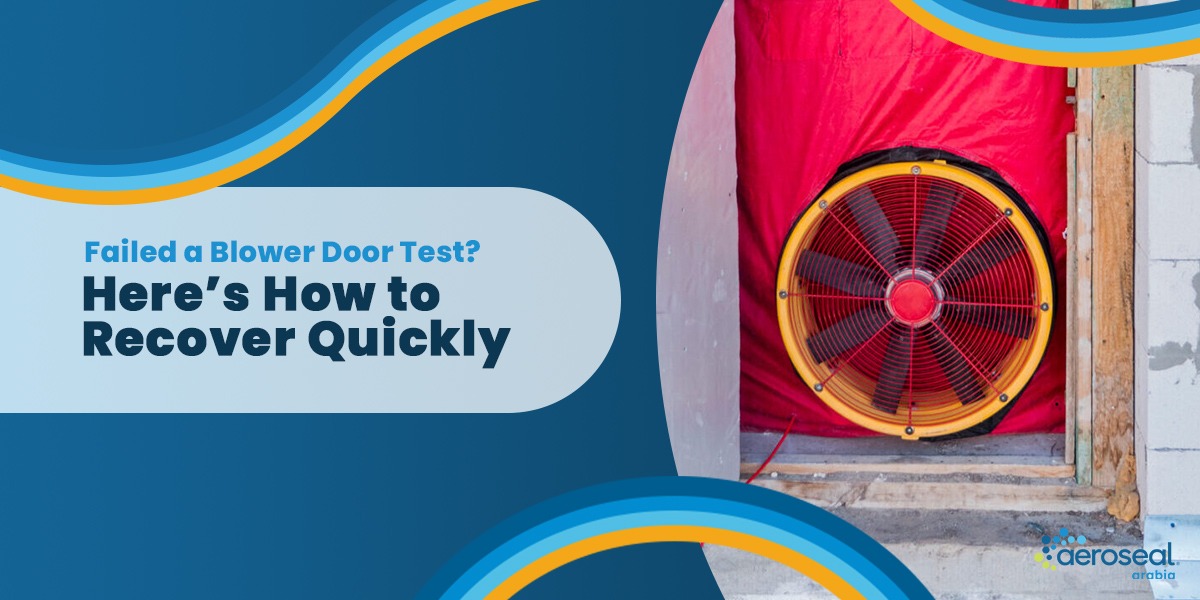
Failed a Blower Door Test? Here’s How to Recover Quickly
Blower door testing has become a key requirement in commercial construction across Saudi Arabia. With the Kingdom’s commitment to Vision 2030, energy efficiency and sustainable buildings are no longer optional they are essential. Schools, hospitals, offices, restaurants, and government facilities must meet airtightness standards to ensure performance, energy savings, and occupant comfort.
So, what happens if your building fails a blower door test? While failure can feel like a major setback, it does not have to derail your project. Understanding why buildings fail, and how to fix the problems effectively, can help you recover quickly and avoid costly delays.
Understanding the Blower Door Test in Commercial Buildings
A blower door test is designed to measure how airtight a building is. During the test, a powerful fan is installed in an exterior doorway to pressurize or depressurize the building. Sensors measure the amount of air that leaks through cracks, joints, and penetrations. The results show whether the facility meets the required air leakage rate set by building codes or project specifications.
For Saudi Arabia’s hot climate, airtightness is critical. Leaky buildings force air conditioning systems to work harder, which drives up energy consumption and operational costs. In sensitive environments like hospitals, poor airtightness can also compromise indoor air quality, patient safety, and infection control.
Why Commercial Buildings Fail Blower Door Tests
Failing a blower door test usually means the building is leaking more air than expected. In large commercial facilities, this is rarely caused by one single issue. Instead, multiple small leaks combine to create significant losses.
Common reasons for failure include:
Unsealed duct and plumbing penetrations
Openings around HVAC ducts or plumbing lines often remain unfinished, allowing conditioned air to escape.
Electrical gaps
Panels, conduits, and outlets can be major leakage points if not sealed properly.
Windows and doors
Even high quality units can fail if the installation is poor, leaving gaps around the frame.
Trade work penetrations
During construction, contractors may cut through the air barrier for wires, pipes, or ventilation without resealing.
Moisture prone areas
Kitchens, restrooms, and service shafts can shift due to humidity, creating new gaps that go unnoticed.
Although each issue may seem minor, together they create significant leakage. For large commercial spaces, even a one percent loss can result in massive wasted energy.
The Consequences of a Failed Test
Failing a blower door test impacts more than just compliance. The effects ripple across cost, schedule, and long term building performance.
- Project delays: Retesting takes time, and each delay can disrupt construction timelines.
- Budget strain: Repeated test and repair cycles consume both labor and materials.
- Energy inefficiency: A leaky building leads to higher cooling demands in cities like Riyadh and Jeddah where temperatures are extreme.
- Occupant discomfort: Uneven airflow results in hot and cold zones, poor ventilation, and reduced indoor air quality.
- Regulatory risk: Non compliant facilities may face penalties or fail to meet Saudi building code requirements.
Understanding these risks is the first step toward addressing them effectively.
How to Recover After a Failed Test
The key to recovering from a failed blower door test is identifying leaks accurately and sealing them properly. Guesswork or quick fixes often lead to repeated failures.
Locate the leaks
Advanced diagnostic tools make leak detection easier and more accurate.
- Blower door with infrared imaging shows temperature differences that reveal hidden cracks.
- Smoke testing makes airflow visible, helping teams spot leaks in real time.
- Airflow meters and hand checks can provide quick confirmation in smaller zones.
Seal with the right materials
Once leaks are identified, using the right materials is critical.
- Caulk works well for fine cracks and joints.
- Expanding foam is better for larger openings.
- Professional grade duct sealants are required for mechanical penetrations.
Every sealed area should be rechecked before moving to the next to avoid missed gaps.
Avoid repeated resealing cycles
In Saudi commercial projects, buildings are large and complex. Manual sealing alone often leaves hidden leaks untouched. This leads to repeated test, repair, and retest cycles that waste time and money. A smarter strategy is needed to pass confidently.
The Smarter Way to Ensure Compliance
Technology now offers a better solution than manual sealing. Aeroseal’s AeroBarrier® system is designed to address leaks comprehensively and efficiently.
Here is how it works: the building is pressurized, and a safe, water based sealing mist is introduced into the space. As air escapes through leaks, the sealant particles bond to the edges, closing gaps automatically. This process reaches leaks that are hidden behind walls, above ceilings, or in hard to access locations.
The benefits for commercial projects in Saudi Arabia are significant:
- Verified in real time: The system continuously measures airtightness until the required standard is met.
- Minimal disruption: Work can continue without major delays, and most projects resume within hours.
- Cost effective: By eliminating multiple rounds of testing and sealing, project budgets are protected.
- Energy savings: Long term performance reduces cooling loads and supports Vision 2030 sustainability targets.
Practical Tips for Contractors and Facility Managers
To avoid future failures and streamline the recovery process, keep these best practices in mind:
- Integrate airtightness planning early in design and construction.
- Train all trades on the importance of protecting the air barrier.
- Conduct interim inspections before the final blower door test.
- Use advanced sealing technology on large or complex projects.
- Document results for compliance and quality assurance.
By following these steps, commercial buildings in Riyadh, Jeddah, and Al Khobar can achieve airtightness standards more efficiently.
Key Takeaway
Failing a blower door test does not mean failure for the entire project. It is a signal that leaks exist, and with the right approach, they can be fixed quickly and effectively. By combining accurate detection, proper sealing methods, and advanced solutions like AeroBarrier, Saudi contractors and facility managers can recover quickly, keep projects on schedule, and deliver energy efficient, high performing buildings that align with the Kingdom’s sustainability goals.



